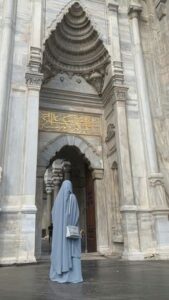There are many different reasons why women choose to wear hijab, a head covering traditionally worn by Muslim women in public and in the presence of men outside of their immediate family. Some women wear Hijab as a symbol of their faith and devotion to Islam, while others see it as a way to express their cultural identity or to assert their independence and autonomy. Here are some of the most common reasons why women choose to wear hijab:
- Religious beliefs and practices: For many Muslim women, wearing Hijab is a way to fulfill their religious obligations and to demonstrate their submission to God. In Islam, Hijab is seen as a symbol of modesty and piety, and wearing it is viewed as a way to honor and protect oneself. The Qur’an instructs Muslim women to dress modestly and to cover their heads and chests when they are in the presence of men outside of their immediate family. Some women see hijab as a way to show their devotion to God and to follow the teachings of Islam, while others see it as a way to protect themselves from unwanted attention and maintain their modesty.
- Cultural and social identity: Wearing Hijab can also be a way for women to express their cultural and social identity. For many Muslim women, Hijab is an integral part of their cultural heritage and a way to connect with their roots and traditions. Wearing hijab can also be a way for women to assert their independence and resist cultural assimilation or Westernization. In some Muslim-majority countries, wearing Hijab is seen as a sign of cultural pride and national identity.
- Personal expression and empowerment: For some women, wearing Hijab is a way to express their individuality and to assert their autonomy and independence. Some women see hijab as a way to challenge societal norms and expectations, and to break free from traditional gender roles and expectations. Wearing hijab can also be a way for women to reclaim their bodies and resist objectification and sexualization. For some women, Hijab is a way to assert their agency and to take control of their appearance and their identity.
- Political and social activism: In some cases, wearing Hijab can also be a way for women to engage in political and social activism and challenge discrimination and oppression. In some countries, wearing Hijab has been seen as a way for women to resist state-imposed secularization or to protest against oppressive regimes. In recent years, Hijab has also been embraced by some non-Muslim women as a way to show solidarity with Muslim women and to challenge Islamophobia and discrimination.
Overall, there are many different reasons why women choose to wear Hijab. For some, it is a deeply personal and spiritual decision, while for others it is a way to express their cultural identity or to engage in political and social activism. Ultimately, the decision to wear hijab is a deeply personal one, and every woman’s reasons for wearing it are unique to her own experiences and beliefs.
Why do women wear Hijab? 8 Amazing info you should know
The Women’s Hijab is divine worship that blends with human instinct
But Some of Evil’s tricks is to separate the Hijab from worship to be a habit so that easier to control the whims of it

The Definition of the veil (Women’s Hijab)
Definition of the veil: A long piece of cloth worn by women as a covering for the head and shoulders, often especially in eastern countries for the face.
Specifically: the outer covering of the Muslim woman’s headscarf
Explanations of the term hijab can be classified into three types: a visual barrier, a physical barrier, and a moral barrier.
- The visual barrier (for example, between Muhammad’s family and the surrounding community) serves to hide something from view.
- A physical barrier creates a space that provides comfort and privacy to individuals, such as elite women.
- The moral barrier, such as the expression purity of hearts in reference to the wives of Muhammad and the Muslims who visit them
Why do women wear Hijab?
Because women are of great value in the religion of Islam and the holy prophet Mohamed recommended women as he described them as precious and delicate glasses.
Therefore, Islam wanted women to remain like a preserved pearl, so it surrounded her with protection and coverage and ordered her to be chaste
It’s well-known that nudity is one of the characteristics of the ignorance era and that the higher the value of a thing, the more intensely it protects and preserves it.
So, scholars have unanimously agreed that the hijab is obligatory for the Muslim, sane, free, adult women.
Women’s hijab in the Qur’an and the Sunnah

Women’s Hijab In QUR’AN
In the verses of the Qur’an, the hijab is worn by Muslim women to maintain modesty and privacy from unrelated males and the seclusion of women from men in the public sphere, The Qur’an instructs Muslim women and men to dress modestly Some Islamic legal systems define this type of modest clothing as covering everything except the face and hands up to the wrists
Of the more than 6,000 verses in the Quran, about a half refer specifically to the way a woman should dress and walk-in public.
The clearest verse on the requirement of modest dress is (And say to the believing women that they should lower their gaze and guard their private parts; that they should not display their beauty and ornaments except what (must ordinarily)) surat el Noor, Quranic verse(31)
In the Qur’an also Muhammad was commanded to ask members of his family and other Muslim women to wear outer clothing when going out so that they would not be harassed (verse)
(O Prophet! You command your wives and your daughters, and the wives of the true believers, that they should cast their outer garments upon their persons (when they are abroad): that is most appropriate, so that they may be distinguished and not be harassed) surat El-Ahzab, Quranic verse(59)
Women’s Hijab IN SUNNAH
The role of the hadith sources is to define the Islamic rules for veiling for women, and to explain the Qur’anic verses narrated by the Companions, which is a major source used by Islamic Sharia scholars to derive their rulings.
and there are guidelines are found in texts of hadith developed after the revelation of the Qur’an but, according to some, are derived from the verses (ayahs) referencing hijab in the Qur’an
And from the evidence of the Sunnah also is his saying, may God’s prayers and peace be upon him, with regard to its meaning: Among the people of Hell are women who are clothed, naked, tilted, their heads tilted like the humps of camel slanting, they will not enter Paradise and they will not find its fragrance. narrated by Muslim
Safiya bent Shaybah narrated: “Aisha used to say: When (the verse): Their veils came down on their chests, (the women) came down, cutting their waists at the edges, and they were veiled with the cut pieces.” Sahih al-Bukhari This hadith is often translated as “…and covers their heads and faces with pieces of cloth.”
Yahya reported on the authority of Malik on the authority of Muhammad bin Zaid bin Qunfudhah that his mother asked Umm Salama, the wife of the Prophet, may God’s prayers and peace be upon him: What clothes does a woman wear during prayer? She said: She prays with the veil and the monastery that reaches down and covers her feet.
Aisha narrated that the Messenger of God, may God bless him and grant him peace, said: “The prayer of a woman who has reached the age of menstruation is not accepted without a veil.” Jami al-Tirmidhi
How to wear the correct women’s hijab ?

But there are many conditions to be wear by correct hijab:
The first condition: that the hijab should cover all the woman’s body, except for the face and hands
The second condition: that the hijab should not be an adornment in itself. God Almighty has forbidden believing women to show their adornment
The third condition: That what is beneath it is not described, nor is it transparent, so it appears what’s under it
The fourth condition: that the woman’s dress should be loose and not tight so that it does not describe anything of the woman’s body, because the purpose of the veil is the dimensions of temptation
The fifth condition: that the hijab should not be perfumed or perfumed; Roses prohibiting women from wearing perfume outside their home
The sixth condition: that you do not imitate men in dress; Cursing was reported on the authority of the Prophet, may God bless him and grant him peace, for a woman who imitates men in her dress
The seventh condition: that she does not intend in her dress to imitate the infidels
The eighth condition: that her dress should not be a dress of fame. Because of the intent of arrogance and pride over them
Finally, the Muslim woman must wear the correct hijab to protect her.
Especially since the veil does not prevent life and is innocent of the meanings of oppression that may be attached to it
Wanna learn more about Islam, you should join our Islamic Classes for kids and adults
Register now and get 2 FREE trial classes


